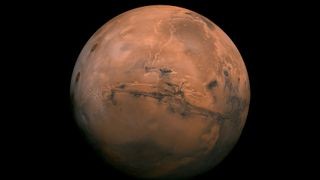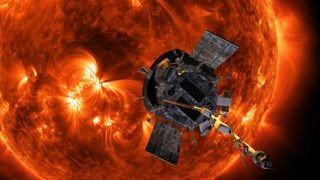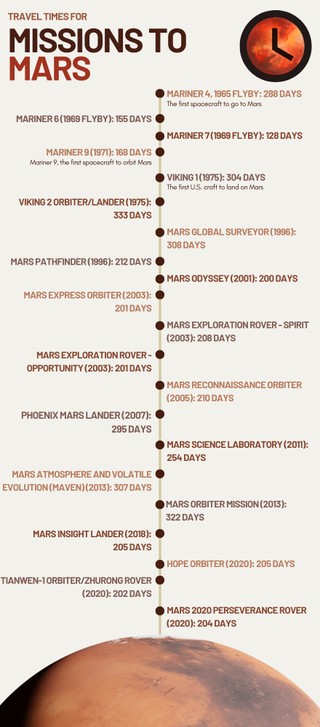Curious about the Mars travel time? Traveling to Mars is a fascinating prospect, and understanding the journey’s duration is key. At TRAVELS.EDU.VN, we break down the factors influencing travel time to the Red Planet and provide insights into this exciting frontier. Let’s explore space exploration, interplanetary travel, and future missions, while planning your dream intergalactic adventure.
1. How Far Away Is Mars From Earth?
The distance between Earth and Mars is constantly changing due to their orbits around the Sun. This variation significantly impacts the time it takes to travel to Mars.
| Scenario | Distance (millions of miles) | Distance (millions of km) |
|---|---|---|
| Closest Possible Approach | 33.9 | 54.6 |
| Closest Recorded Approach | 34.8 | 56 |
| Farthest Approach | 250 | 401 |
| Average Distance | 140 | 225 |
According to NASA, the average distance between Earth and Mars is about 140 million miles (225 million kilometers). However, the actual distance varies as both planets follow elliptical orbits around the Sun.
 Illustration showing the Earth, Mars, and the Sun, emphasizing the changing distances between the planets due to their elliptical orbits.
Illustration showing the Earth, Mars, and the Sun, emphasizing the changing distances between the planets due to their elliptical orbits.
2. How Long Would It Take To Travel To Mars At The Speed Of Light?
If we could travel at the speed of light, the journey to Mars would be relatively quick. However, even at this incredible speed, there would still be a delay.
| Scenario | Time to Reach Mars |
|---|---|
| Closest Possible Approach | 182 seconds (3.03 minutes) |
| Closest Recorded Approach | 187 seconds (3.11 minutes) |
| Farthest Approach | 1,342 seconds (22.4 minutes) |
| Average Distance | 751 seconds (12.5 minutes) |
According to Space.com, light travels at approximately 186,282 miles per second (299,792 km per second).
3. What Is The Fastest Spacecraft And How Quickly Could It Reach Mars?
The fastest spacecraft to date is NASA’s Parker Solar Probe. If this probe were redirected to Mars, it could theoretically reach the planet much faster than current missions.
| Scenario | Travel Time |
|---|---|
| Closest Possible Approach | 78.84 hours (3.3 days) |
| Closest Recorded Approach | 80.93 hours (3.4 days) |
| Farthest Approach | 581.4 hours (24.2 days) |
| Average Distance | 325.58 hours (13.6 days) |
On December 24, 2024, the Parker Solar Probe reached a top speed of 430,000 miles per hour (692,000 km per hour), according to BBC Newsround.
 Graphic illustrating the Parker Solar Probe's trajectory around the Sun, highlighting its record-breaking speed and potential for rapid interplanetary travel.
Graphic illustrating the Parker Solar Probe's trajectory around the Sun, highlighting its record-breaking speed and potential for rapid interplanetary travel.
4. What Factors Affect Mars Travel Time For Spacecraft?
Several factors influence the time it takes for a spacecraft to travel to Mars. These include energy expenditure, orbital mechanics, and planetary alignment.
4.1 Energy Expenditure
The amount of energy required for the journey significantly impacts travel time. Higher energy expenditure can shorten the trip, but it also requires more propellant and advanced propulsion systems. As Michael Khan, ESA Senior Mission Analyst, explains, spaceflight is about the clever management of energy.
4.2 Orbital Mechanics
The positions of Earth and Mars in their orbits around the Sun dictate the optimal launch windows and trajectories. These windows occur approximately every 26 months. The “pork chop plot” is a common tool used by trajectory experts to determine the required dates of departure and arrival, as well as the amount of energy required.
4.3 Planetary Alignment
The alignment of Earth and Mars is crucial for minimizing travel time. Launches must be timed to ensure that Mars is in the correct position when the spacecraft arrives. According to NASA Goddard Space Flight Center’s website, the ideal lineup for a launch to Mars occurs roughly every 26 months and results in a journey of about nine months.
5. Why Are Journey Times Longer For Spacecraft Intending To Orbit Or Land On Mars?
Spacecraft intended to orbit or land on Mars face additional constraints that increase travel time compared to flyby missions.
5.1 Orbit Insertion
Entering Mars orbit requires a significant amount of propellant for orbit insertion maneuvers. This necessitates a slower arrival velocity, which extends the overall travel time.
5.2 Atmospheric Entry
Landing on the surface of Mars requires a heat shield to withstand the loads of atmospheric entry. The design and construction of this heat shield impose limitations on the spacecraft’s arrival velocity, further increasing travel time.
6. What Are The Challenges In Calculating Accurate Travel Times To Mars?
Calculating accurate travel times to Mars is complex due to several factors.
6.1 Non-Linear Trajectories
Spacecraft do not travel in a straight line between Earth and Mars. They must move in orbit around the Sun, following curved trajectories.
6.2 Constant Motion
The planets are constantly moving at different rates during their orbits around the Sun. Engineers must calculate the ideal orbits, considering the changing positions of Earth and Mars.
6.3 Velocity Requirements
Spacecraft need to arrive at Mars with a velocity that allows for orbit insertion or landing maneuvers. This requirement limits the maximum speed at which they can travel.
7. How Long Did Previous Mars Missions Take To Reach The Red Planet?
Historical missions to Mars have varied in duration, depending on the mission objectives and technologies used.
 Infographic showing the timeline of various missions to Mars, including launch dates and travel times.
Infographic showing the timeline of various missions to Mars, including launch dates and travel times.
8. Can Technology Shorten The Flight To Mars?
Evolving technology has the potential to significantly shorten the flight to Mars.
8.1 Space Launch System (SLS)
NASA’s Space Launch System (SLS) is designed to carry upcoming missions, including human missions, to Mars. The SLS aims to provide more efficient and faster transportation to the Red Planet.
8.2 Photon Propulsion
Photon propulsion, using powerful lasers to accelerate spacecraft to velocities approaching the speed of light, could drastically reduce travel time. Philip Lubin, a physics professor at the University of California, Santa Barbara, is working on Directed Energy Propulsion for Interstellar Exploration (DEEP-IN). This method could propel a robotic spacecraft to Mars in just three days, according to the 2015 NASA Innovative Advanced Concepts (NIAC) fall symposium.
9. What Are The Human Health Risks Of A Mission To Mars?
A mission to Mars poses several human health risks due to the harsh environment and extended travel time.
9.1 Radiation Exposure
Astronauts would be exposed to high levels of radiation during the journey, increasing the risk of cancer and other health problems.
9.2 Psychological Effects
The isolation and confinement of a long-duration space mission can lead to psychological stress, anxiety, and depression.
9.3 Physiological Effects
Prolonged exposure to microgravity can cause bone loss, muscle atrophy, and cardiovascular problems.
10. What Are The Key Considerations For Planning A Human Mission To Mars?
Planning a human mission to Mars requires careful consideration of several key factors.
10.1 Life Support Systems
Reliable life support systems are essential to provide astronauts with air, water, food, and waste management.
10.2 Propulsion Systems
Advanced propulsion systems are needed to reduce travel time and radiation exposure.
10.3 Habitat Design
The design of the habitat must provide a comfortable and safe living environment for astronauts during the long journey.
10.4 Medical Support
Comprehensive medical support, including diagnostic and treatment capabilities, is crucial for addressing health issues that may arise during the mission.
10.5 Risk Mitigation
Strategies to mitigate the risks associated with radiation exposure, psychological stress, and physiological effects must be developed and implemented.
Ready To Explore The Possibilities Of Space Travel?
At TRAVELS.EDU.VN, we’re passionate about making even the most complex journeys accessible. While a trip to Mars might be a bit further off, let us help you plan your next adventure here on Earth.
Why Choose TRAVELS.EDU.VN For Your Travel Needs?
- Personalized Service: We understand that every traveler is unique. Our experts take the time to understand your preferences, budget, and travel style to create a bespoke itinerary just for you.
- Unparalleled Expertise: With years of experience in the travel industry, our team has the knowledge and connections to ensure a seamless and unforgettable experience.
- Exclusive Access: Benefit from our partnerships with top hotels, wineries, and tour operators in Napa Valley, giving you access to experiences you won’t find anywhere else.
- Peace of Mind: From booking flights and accommodations to arranging tours and activities, we handle all the details so you can relax and enjoy your vacation.
Discover Napa Valley With TRAVELS.EDU.VN
Napa Valley offers a wealth of experiences to delight every traveler. From world-class wineries and gourmet restaurants to stunning landscapes and luxurious spas, there’s something for everyone to enjoy. Let TRAVELS.EDU.VN be your guide to this enchanting destination.
- Wine Tasting Tours: Explore the renowned wineries of Napa Valley with our expertly curated wine tasting tours. Sample award-winning wines, learn about the winemaking process, and enjoy breathtaking views of the vineyards.
- Gourmet Dining Experiences: Indulge in exquisite cuisine at Napa Valley’s top-rated restaurants. From farm-to-table fare to Michelin-starred establishments, our dining experiences are sure to tantalize your taste buds.
- Outdoor Adventures: Discover the natural beauty of Napa Valley with our outdoor adventures. Hike through scenic trails, bike along picturesque routes, or soar above the vineyards in a hot air balloon.
- Luxury Accommodations: Relax and rejuvenate in Napa Valley’s finest hotels and resorts. From boutique inns to lavish estates, our accommodations offer unparalleled comfort and style.
FAQ: Your Questions About Mars Travel Answered
- How long does it take to get to Mars?
- The journey to Mars typically takes around nine months, but this can vary depending on the specific trajectory and propulsion system used.
- What is the closest distance between Earth and Mars?
- The closest recorded approach occurred in 2003 when they were only 34.8 million miles (56 million km) apart.
- Can humans travel to Mars in the near future?
- Yes, NASA and other space agencies are actively planning human missions to Mars, with potential launches in the coming decades.
- What are the main challenges of traveling to Mars?
- The main challenges include the long travel time, radiation exposure, and the need for advanced life support systems.
- How often does the launch window to Mars occur?
- The launch window to Mars occurs approximately every 26 months when Earth and Mars are properly aligned.
- What is photon propulsion, and how can it shorten the flight to Mars?
- Photon propulsion uses powerful lasers to accelerate spacecraft to velocities approaching the speed of light, potentially reducing travel time to just a few days.
- What are the health risks associated with a mission to Mars?
- Health risks include radiation exposure, psychological effects, and physiological effects such as bone loss and muscle atrophy.
- What technologies are being developed to improve space travel to Mars?
- Technologies include the Space Launch System (SLS) and Directed Energy Propulsion for Interstellar Exploration (DEEP-IN).
- How do scientists calculate the travel time to Mars?
- Scientists use orbital mechanics and trajectory optimization, considering the positions of Earth and Mars in their orbits around the Sun.
- What is the “pork chop plot” in the context of Mars travel?
- The “pork chop plot” is a diagram used by trajectory experts to determine the required dates of departure and arrival and the amount of energy required for Mars transfers.
Ready To Plan Your Next Adventure?
Don’t wait for a trip to Mars to start exploring. Contact TRAVELS.EDU.VN today to discuss your dream vacation to Napa Valley. Let us handle the details while you anticipate an unforgettable experience.
Contact Information:
- Address: 123 Main St, Napa, CA 94559, United States
- WhatsApp: +1 (707) 257-5400
- Website: TRAVELS.EDU.VN
Let travels.edu.vn help you create memories that will last a lifetime. Space may be the final frontier, but Napa Valley is ready for you now.